|
The main focus of the design is the Main Activity or Prayer Hall which combined two existing triangular shaped stepped lecture halls into a new, single level, symmetrical, east oriented room for two hundred worshippers. The challenge of the Hall was to create a spiritually evocative space that was not referential or biased to any one faith group. The room also had to accommodate those faiths that worship iconographically and those that worship iconoclastically, with and without symbols.
To accommodate the aesthetic, symbolic and spiritual needs of these religions the Hall was designed to be as non-exclusive as possible. All sensitivities were taken into consideration. Our goal was to avoid all religious ornamentation and symbolism, but include key elements to satisfy all religions (such as facing Mecca) and then create one single element that was common to all. That common element was light, in both the spiritual and metaphysical sense.
  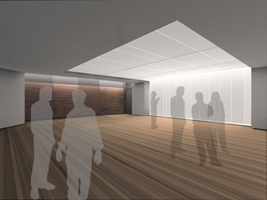
The expression of light was the distinguishing feature of the space. Framed in Venetian Plaster is 80 SM of glowing, back lit ceiling and front wall. The gesture is minimal with a custom support ceiling system and hidden alcoves on the front wall which, when open, reveal the icons of four of the most active faith groups on campus.
The search for the right translucent material began with plastics and polyesters, fabrics and decorative papers laminated to glass. With considerable effort and examination of the budgets the final material will be white onyx laminated to glass, chosen for the natural texture and evocative variation in the stone. For ease of installation and ceiling accessibility the 39 kg/SM ceiling had to be panelized. This was achieved by dividing the panels using geometries and proportions significant to different religions. In doing so we were able to address the symbolic references significant to many of the different participating religions.
This mosaic creates a lit field which not only creates a edifying ambiance but brings together the spirituality of all religions.
Underlying Geometry:
Square:
Hindu - Temple plan is based on the interconnection of a square and circle. The square represents the terrestrial life and its absolute and mystical form.
Buddhist - Square is the basis of all temple plans.
Islam - Square is a perfect and sacred shape.
Christianity - A Christian cathedral is laid out in a cross which is the form of an unfolded cube.
4 Divisions:
Hindu - Terrestrial life is governed by the number 4 referencing the cardinal points.
Sikh - 4 stages of spiritual evolution.
3 Divisions:
Islam - Prayer beads are grouped into 3rds at 33 each, representing the 99 names for God.
Hindu - 33 divinities.
Sufism - 33 is a sacred number.
Judaism - 33 represents the secret levels of creation. The Jewish Star of David consists up of 2 triangles. 3 is the symbol of holiness.
Christianity - Holy Trinity.
Buddhism - The core of Buddhism is made up of the three pillars (triple gem) of the Buddha, the Dharma (his teachings) and the Sangha (monks and nuns).
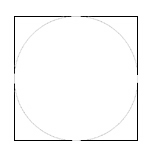 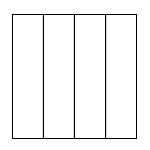 
12 Divisions:
Judaism - Synagogues usually have 12 windows depicting the 12 tribes of Israel. Reminds people that worship is not singular but communal.
1/3 Divisions:
Each rectangle is divided into 1/3 to 2/3 proportion in reference to the 3 divisions.
8 Divisions:
Hindu - Mandala is the model of the Cosmos consisting of 64 deities. (8x8 = 64)
Buddhism - The 8 spoked Dharma wheel is one representation of Buddha symbolizes the Buddha's turning the wheel of truth and law.
Judaism - The menorah has 8 candles representing the 8 days of Chanakah.
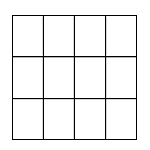 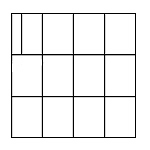 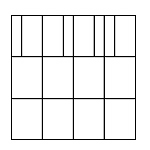
Mosaic Field (Mandala):
The word "mandala" is from the classical Indian language of Sanskrit. Loosely translated to mean "circle." A mandala is far more than a simple shape. It represents wholeness, and can be seen as a model for the organizational structure of life itself - a cosmic diagram that reminds us of our relation to the infinite, the world that extends both beyond and within our bodies and minds.
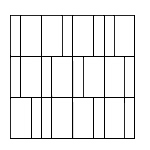 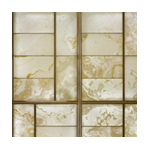
Mandala in Religion:
In Asia, the Taoist "yin-yang" symbol. In the Americas, Indians have created medicine wheels and sand mandalas. Both Navajo Indians and Tibetan monks create sand mandalas to demonstrate the impermanence of life.
Mandala in Nature:
The "circle with a center" pattern is the basic structure of creation that is reflected from the micro to the macro in the world as we know it. It is a pattern found in nature and is seen in biology, geology, chemistry, physics and astronomy.
Mandala in Architecture:
From Buddhist stupas to Muslim mosques and Christian cathedrals, the principle of a structure built around a center is a common theme in architecture. A Hindu temple is designed in a grid, usually of 64 or 81 squares, it is a model of the cosmos (mandala), with each square belonging to a deity.
|










